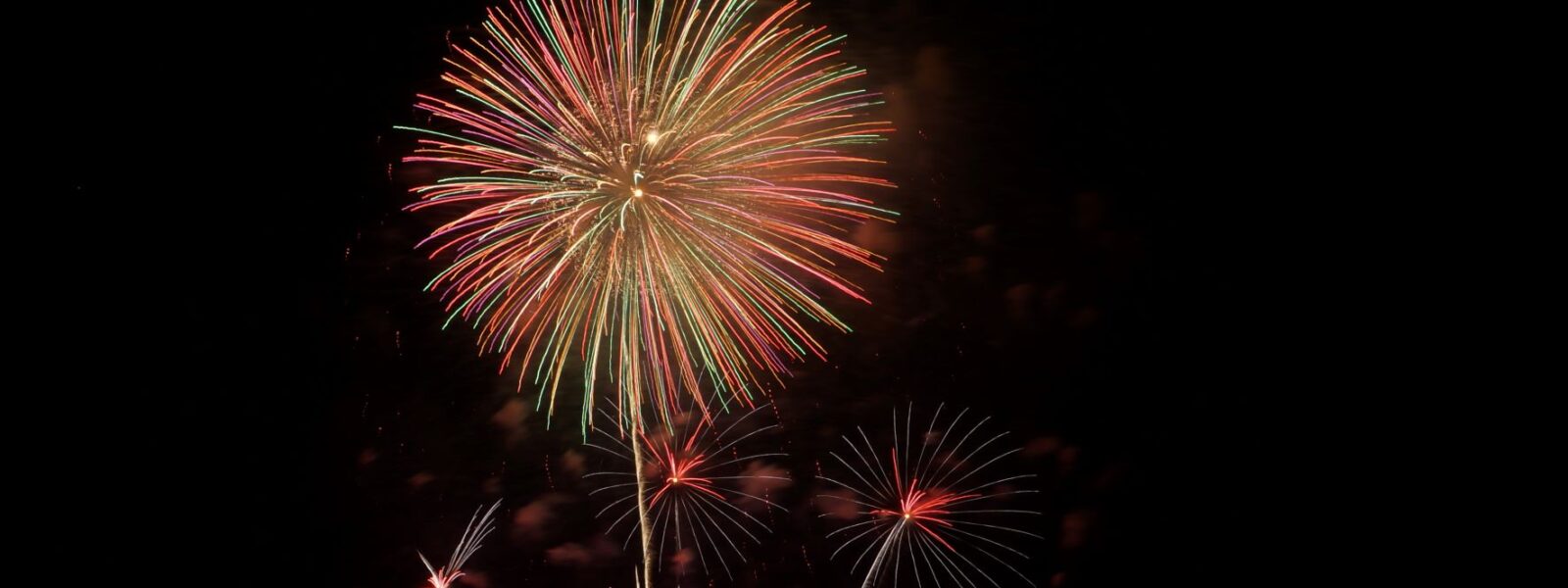Products
1. The size of fireworks
In Japan, the size of the spherical aerial shell is normalized according to a traditional Japanese measuring system. Large shells over No. 10 are especially called “shaku-dama”, and their dynamic size and sounds are attractive to our Japanese audiences.
The size of fireworks [Japan Pyrotechnics Association, 2009:18-19]
| Size [No.] | 3 | 5 | 7 | 10 | 20 |
| Diameter of a mortar[m] | 0.09 | 0.15 | 0.21 | 0.30 | 0.60 |
| Shell burst height [m] | 120 | 190 | 250 | 330 | 450 |
| Max. width of the burst in the air [m] | 60 | 150 | 200 | 280 | 500 |
Cf. Tokyo Tower, Tokyo: H 333m, W 80m
2. Spherical aerial shells
Spherical aerial shells contain many small balls or pellets of pyrotechnic compounds, called stars. This type of fireworks is the most popular in Japan and an aesthetic level and quality of production techniques are required. When the shells are formed so tightly that they break in the air making a symmetrical sphere, the fireworks are called “warimono”. On the other hand when the shells are formed softly and the stars inside the shells break in the air making irregular or random movement, the products are called “pokamono”.
In the following sections we would like to introduce you to typical warimono and pokamono shells, followed by other spherical aerial shells, small fireworks and set pieces. In the last section we have some videos of starmine shows.
3. Warimono
Warimono shells are identified by their color(s) and types of stars, the number of hearts, and their rising effects.
3-1. A nomenclature
3-1. (a) The types of the spherical fireworks
There are 3 main types of warimono: peony, chrysanthemum and willow. The appearances of warimono fireworks change according to the speed and length of the burning stars.

When the stars burn quickly and the fireworks ball expands in a straight radial direction, it is called a peony shell. For this the stars do not have long-tailed effect. A chrysanthemum shell uses comet stars, which do have a long-tailed effect. Thus the appearance of the chrysanthemum type has long-tailed petals when the fireworks ball expands to its maximum size. The stars of willow or kamuro (a hairstyle of ancient Chinese infants) have the maximum duration and distance of burning in these three types. When a willow shell breaks in the air, the stars expand and gradually fall with the force of gravity before they burn off. Then the fireworks ball forms the shape of willow tree.
Though these three types of warimono shells are the most familiar in Japan, the types of wariono fireworks are not confined to them. For example, a type of shell constructed of relatively large size and small number of stars compared to those in chrysanthemum is also popular. The stars have a long-tailed effect, but do not trail down as long as those of willow. This type is called palm.
| (i) Peony | (ii) Chrysanthemum | (iii) Willow / Kamuro | (iv) Palm |
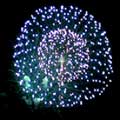 | 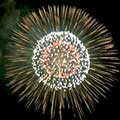 |  | 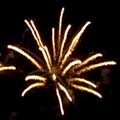 |
| Blue peony with purple heart | Green-to-red chrysanthemum with double heart of red and yellow | Red willow | Palm |
3-1. (b) Number of hearts
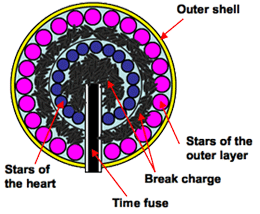
Warimono fireworks are often constructed of single or multiple core structures (heart) inside the outer layers as illustrated on the right. In Japan, each product is named according to the number of hearts. (Ex. chrysanthemum with a single heart)
3-1. (c) Rising effects
In some cases, small parts are attached to the top of warimono shells as shown in the illustration below. The parts are components filled with pyrotechnic chemicals and ignited by the firing of the lift charge in the mortar. That is earlier than the ignition of the break charge of the warimono shell. When fired, these components are set off during the rise of the shell. They are used to accentuate the effect of the warimono shells to which they are attached. The components make a whistling sound, emit light with tailed effect, or break one after another.

In the following two sections, we would like to introduce our special warimono shells of magical peony and fireworks on the water.
3-2. Magical peony
San-en Fireworks was awarded a prize for the invention of the stars of “magical peony” in 1968, and these have long been one of our representative works. After the fireworks ball of magical peony is ignited and bursts in the air, the stars disappear for a few seconds, and are lightened again while expanding to its maximum width.
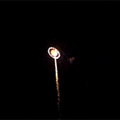 | 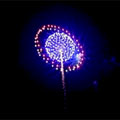 | 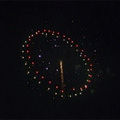 | 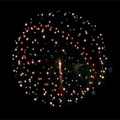 | 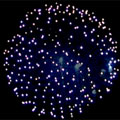 |
| 1. The beginning of the burst of magical peony with yellow and red rings | 2. Blue peony with red and yellow rings outside | 3. The hollow sphere of blue stars loses its brightness for a while… | 4. And start to burn off again. | 5. The maximum size of fireworks in the air. |
3-3. Fireworks on the water
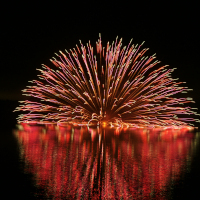
When a spherical aerial shell bursts just above the water, the upper side of the hemisphere appears on the surface. The stars of the lower side go shallowly under the water. These fireworks are often displayed on a lakeside or at seashore events.
4. Component shells1, Clusters
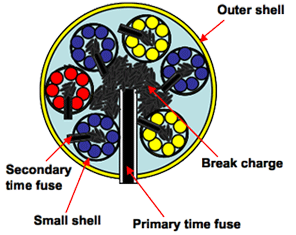
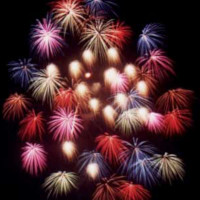
Component shells are a type of spherical aerial shells that are constructed of smaller pyrotechnic components. These have two steps of ignition with primary and secondary time fuses that are fabricated in the component shells. To make cluster fireworks balls, many small warimono shells of the same sort are packed inside large outer shells as shown in the illustration below. Fire is introduced simultaneously from the secondary time fuses of small shells when the break charge is ignited. Then the small shells burst at the same time and clusters of blooms appear as shown in the photo below.
5. Component shells2, Bees and Whistles (Pokamono)

Similarly as cluster fireworks, small components of softly formed shells (poka) or noisemakers are packed inside pokamono shells as illustrated below. Pokamono shells containing components that move in irregular directions with the spiral movement of flames are called ‘bees’. This is shown in the movie below.
6. Irregular shapes
When several different colors or other effects of stars are used and form a pattern inside the warimono shell, the pattern appears after the shell bursts in the air. Examples of irregularly shaped spherical aerial shells of butterfly and sunflower are shown on the right. However in many cases, the patterns can be seen from only one plane, although spherical aerial shells break facing in a random direction. For this several of the same sorts of fireworks balls are prepared, or weight devices are attached to the outer shell to control the direction of the burst.
 |  |
| Butterfly | Sunflower |
7. Small fireworks
Small fireworks are displayed at lower heights compared to spherical aerial shells. These fireworks are used to apply dramatic visual effects and rhythms of shooting sounds during starmine shows. The small fireworks are composed of bunches of stars or pyrotechnic chemicals and sets of mortars. Comet fronts are sets of preloaded pellet comets, and mines are devices that are preloaded stars on the mortars.
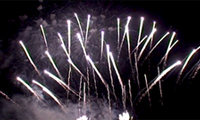 |  |
| Comet front | Mine |
8. Set pieces
Set pieces are also called ground pieces. They are set on structures constructed of poles or frames that are stabilized on the ground. Gerbs (a tube device solidly filled with pyrotechnic composition) are connected with quick matches (a type of fuse) and are attached to these structures.
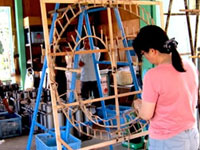 | 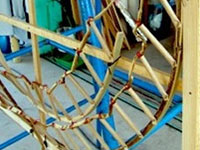 |
| A lacework of smiling face | Gerbs attached to the set piece |
Letters and illustrations of sparks can be drawn on these set pieces by preparing the frame structures as shown in the photos on the right. These set pieces are called laceworks.
Other examples include cascades (waterfalls) that can show dynamic visual effects by their rushing sparks that run between two poles. Wheels are revolving set pieces constructed on a freely rotating shaft. When the wheels are ignited and start to spin rapidly, the sparks from the gerbs show spiral patterns as shown in the photo on the right.
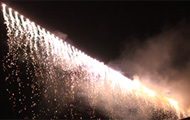 |  |
| Cascade (Waterfall) | Wheel |
9. Starmine
Starmine is a series of fireworks display that include spatial and auditory effects, lasting between 1 and 10 minutes in Japan.
Electrical ignitions are used for many of our starmine events. Since the timings of ignitions are controlled using computer devices, the technology enables us to fire pyrotechnics with precision. As a consequence, pyrotechnicians can compose starmine shows utilizing the maximum possible space and synchronize the fireworks with music.
We are eager to present impressive fireworks shows to our audiences highlighting the technological and aesthetic skills of our pyrotechnicians.
Please see the gallery page to check the videos of our starmine show
10. References
A large part of this page refers to
J. Pyrotech. 1996. “The illustrated dictionary of pyrotechnics” J. Pyrotech. Inc. and
J. Pyrotech. 2005. “Lecture notes for fireworks display practices” ” J. Pyrotech. Inc.
